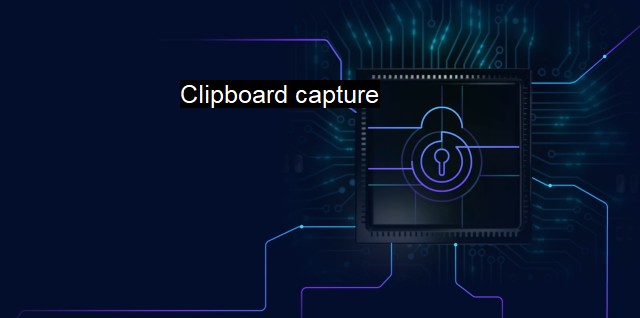What is Clipboard capture?
The Dark Side of Clipboard Capture: Understanding the Increasing Cybersecurity Risks and Threats Posed by Clipboard Functions
Clipboard capture is a technique where malicious software (malware) steals information that is temporarily stored on the computer's clipboard. Sometimes referred to as 'clipboard hijacking,' this type of stealthy attack can have serious implications for both individuals and businesses.The clipboard is an inherent feature in most operating systems that provides a short-term storage space for data that is being copied or moved from one place to another within or between applications. When you press Ctrl+C or "Copy" on your computer, the copied content is stored on the clipboard. This could potentially include sensitive information like account username and passwords, credit card details, confidential documents, or even personal communications.
In the context of clipboard capture attacks, a cybercriminal uses a piece of malware to infiltrate a computer network, usually via spam emails, infected websites, or malicious mobile apps. Once the malware is installed, it quietly monitors clipboard activity and captures any information that is copied or cut to the clipboard. This information is then encrypted and sent back to the cybercriminal, who then uses it for data theft, unauthorized access, credit card fraud, identity theft, or other cyber-attacks.
Clipboard capturing is particularly dangerous because it often happens unnoticedly and without any explicit action by the user except for copying data. most security measures, including antivirus software, are typically not equipped to look for this type of attack.
This technique is even more worrisome when it comes to the growing usage of cryptocurrencies. Several types of clipboard hijacking malware specifically target cryptocurrency transactions. They typically look for Bitcoin or other cryptocurrency addresses that users have copied to the clipboard for transferring funds. The malware swiftly replaces the user's address with an address controlled by the cybercriminal. As a result, the funds are transferred directly to the cybercriminal's account, without the user knowing they've been hijacked until it's too late.
While clipboard capturing is just one of the many threats presented by cybercriminals, there are several steps individuals and companies can take to protect against it. The first line of defense is always to ensure that the most up-to-date antivirus software is in use. Antivirus software manufacturers are continually updating their products to guard against the latest threats, including clipboard catchers.
In addition to antiviruses, a manual review of your computer's programs and applications can also aid in the detection of malware. Any program that you do not recognize or did not directly download should be regarded as suspicious and warrants an immediate investigation.
An added layer of protection comes in the form of regularly changing passwords to minimize the opportunity for cybercriminals to exploit. If a password is captured then subsequently changed, the stolen password becomes worthless.
Being familiar with common avenues hackers use to install malware like deceptive pop-up ads or suspicious email attachments, should be avoided at all costs. Any unknown email attachments, for instance, can potentially inject malware into the computer system.
Clipboard capturing is a cyber threat that involves the stealthy and unwanted copying of information that a user places on the computer's clipboard. It's an arena of cybersecurity that is somewhat under-resourced in terms of research and protection measures, which makes it important for all users to keep abreast of the latest protection techniques. Despite the challenges, a strong antivirus setup and awareness of the nature of these attacks will go a long way towards defending valuable data from clipboard capture attempts.

Clipboard capture FAQs
What is clipboard capture?
Clipboard capture refers to a method of gaining unauthorized access to the contents of the clipboard, which is a temporary storage area used by various computer applications. This method can be used to steal sensitive information such as passwords, credit card details, and other personal data.How can clipboard capture be prevented?
To prevent clipboard capture, you can use antivirus software that includes clipboard protection. This feature will alert you when an application tries to access your clipboard and will give you the option to deny access. Additionally, you can avoid copying sensitive information to the clipboard and instead type it directly into the application where it will be used.What are the risks of clipboard capture?
The risks of clipboard capture include the theft of sensitive information such as passwords, credit card details, and other personal data. This information can be used for identity theft, financial fraud, and other malicious activities. Additionally, clipboard capture can be used to install malware on your computer, which can cause further damage and compromise your cybersecurity.Is clipboard capture a common method used by cybercriminals?
Yes, clipboard capture is a common method used by cybercriminals to steal sensitive information. It is often used in combination with other methods such as phishing and social engineering to trick users into revealing their information. Additionally, some malware programs are specifically designed to capture clipboard data and transmit it to the attacker.| | A | | | B | | | C | | | D | | | E | | | F | | | G | | | H | | | I | | | J | | | K | | | L | | | M | |
| | N | | | O | | | P | | | Q | | | R | | | S | | | T | | | U | | | V | | | W | | | X | | | Y | | | Z | |
| | 1 | | | 2 | | | 3 | | | 4 | | | 7 | | | 8 | | |||||||